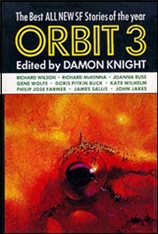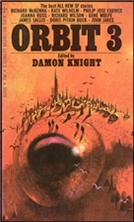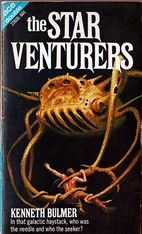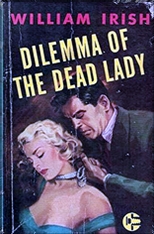DAMON KNIGHT, Editor – Orbit 3, G.P. Putnam’s Sons, hardcover, June 1968. Cover art by by Paul Lehr, Berkley S1608, paperback, September 1968. Cover art also by Lehr.

Damon Knight has gone off the deep end, I’m afraid, in his search for literary excellence in SF. Of these nine selections, two have straightforward stories to go with their messages, and of the other seven, only one has any message which seems important enough to be reading about. Maybe we should be grateful that most of these others are the shorter ones. ***
RICHARD WILSON “Mother to the World.” Novelette. The story. combined with personal diaries, of the last couple in the world, with an added twist. It is well that Martin Rolfe has a basic love and understanding for animals, since Siss, while a normal woman in all other aspects, has the mentality of an eight-year-old. Consideration slowly becomes love, as we watch, hoping that nothing happens to spoil it, and a family is begun. A family that may have a future. (5)
RICHARD McKENNA “Bramble Bush.” Novelette. Knight was right the first time: that is, I did not understand a word either. It is remarkable that an author makes no concessions to the reader in the interpretations of his visions. Here is an example, however, with theories of the fourth dimension. (0)
JOANNA RUSS “The Barbarian.” Novelette. Alyz meets a fat man who may or may not be a time traveler, but who is someone who thinks he is the master of his machines, yet who in his foolishness is inferior to Alyx. Confusing story, but a message lurks somewhere. (4)

GENE WOLFE “The Changeling.” Knight doesn’t understand this, shall I argue? The [relatively] high rating is based not on the possibility there might be a meaning, but on the reminiscences of small town life. (2)
DORIS PITKIN BUCK “Why They Mobbed the White House.” Why indeed? I thought this story might explain. Something about computers and income tax. (1)
KATE WILHELM “The Planners.” A glimpse into the life of the head of a research project which is trying to stimulate the intelligence of monkeys. But a glimpse is all. (2)
PHILIP JOSE FARMER “Don’t Wash the Carats,” What does it mean if a “literary Rorschach test” is nothing but nonsense to you? (0)
JAMES SALLIS “Letter to a Young Poet.” Well, that’s what it is. What did you expect? (3)
JOHN JAKES “Here Is Thy Sting.” Novelette. A newspaperman discovers a scientific project probing the experience of death from a qualitative approach. Of the two essential parts, the sleep and the pain, which is it that mankind fears? And if the fear of the pain were to be eliminated, what would be the effect on the future of mankind? And why was this story described as funny? Or amusing? ****½
— February 1969.










